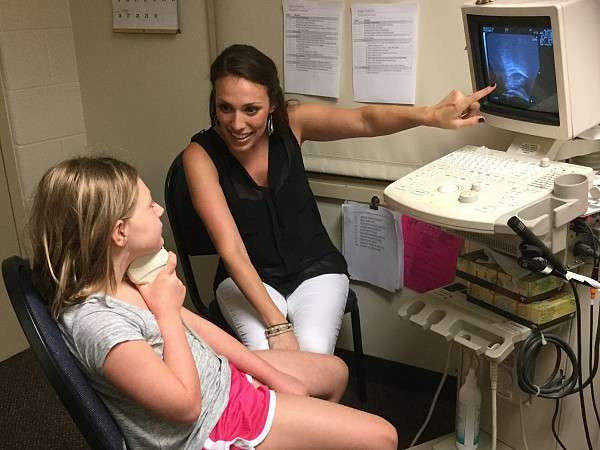Technology takes speech therapy to new heights

Ultrasound technology is showing speech therapy patients how their tongues work, thanks to the University of Cincinnati (UC) Speech, Language and Hearing Clinic in the College of Allied Health Sciences (CAHS). More than 30 clients received articulation ultrasound therapy this summer during a pair of two-week camps in June and July.
The camps are an extension of the clinic, which is an ongoing research project that began in 2009. It is also one of the services CAHS graduate students participate in as part of their clinical practicum.
Suzanne Boyce, PhD, a professor of speech pathology and speech science in the Department of Communication Sciences and Disorders (CSD), is a joint investigator with Sue Schmidlin, a clinical instructor in CSD, in ongoing research testing the effectiveness of ultrasound biofeedback therapy for children and adults with persistent speech sound disorders and to develop effective treatment protocols.
For almost 20 years, Boyce has been working on a research project using magnetic resonance imaging (MRI) and ultrasound imaging of people speaking to impact the way clinicians approach speech sound disorders.
"Speech pathologists have been working kind of blind, in trying to teach people how to change their pronunciation," Boyce says. "Before we had ultrasound and MRI technology there was no safe way to actually image what was happening in the vocal tracts in the throat."
The use of ultrasound has been particularly effective when providing therapy for children and teens struggling with the "R" sound, according to Boyce. "Different people are doing different things when trying to speak but all the books written on how people say "R" were based on how the author themselves said it," says Boyce. "We're discovering that everyone can't use the same tongue shape and be successful."
Boyce founded the UC Speech, Language and Hearing Clinic to provide therapy for children struggling with the "R" sound who had not been successful with the traditional speech language pathologist (SLP) approach.
"Most of the time, the typical clinical intervention works fine, it's just that there's this group that it never worked for," says Boyce. "We thought the ultrasound was something new we can do to possibly help this group that nobody has been able to help and put it together with finding out if looking at a picture of their own tongue would help determine what would work and what wouldn't."
"The results of Dr. Boyce's research have shown that a constriction or narrowing in the pharynx is one of the critical elements for correct 'R' production," says Schmidlin, who is also director of the Speech, Language and Hearing Clinic. "To facilitate this, the clinician can direct the client to focus on the back part of the tongue and give verbal cues about positioning the tongue while the client is attempting to produce 'er'."
Camp Boosts Speech Confidence
Two separate camps are held in the summer for parents who want their children to have an intense dose of therapy using ultrasound. The sessions this past June and July attracted 33 clients. Jamie Hamilton of Loveland brought her 8-year-old daughter Lola to the camp in July.
"During the first day of the camp, Lola had to learn the different parts of the tongue," Hamilton said. "She now knows the root, and what to do with the root and the flaps. It's just basic tongue terminology so that if the speech therapist told her what to do with her tongue she understood that."
Hamilton says Lola's personality fit very well with her camp therapist, Lexie Lopez-Mayo, a graduate student in the SLP program in CAHS. That comfort level gave Lola the added element of confidence as she learned techniques to help her make the correct "R" sound.
While Lopez-Mayo was teaching tongue techniques to her clients, she was also learning concepts that will help her as she pursues a career as a speech language pathologist.
"I really feel like I'm leaving with an arsenal of strategies of how to help kids properly," Lopez-Mayo says. "Visual cues, different phrases that really give kids a good idea of what it is that I'm looking for in them."
The summer camp clients had varying degrees of success with their therapy. The key, says Anna Brogan, a graduate student in the SLP program, is giving them some strategies to take home.
"Even if the kids don't make as much progress as you want them to, at least they have the knowledge of what needs to happen," says Brogan. "So they can even go and tell their next therapist what they learned here. Just giving them the knowledge of what needs to happen is a big step."
"We're fortunate to have UC here for a lot of reasons but for me personally right now this is a big one," says Hamilton. "I'm very thankful UC has this cutting edge program."

















